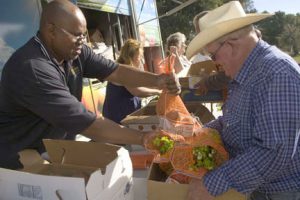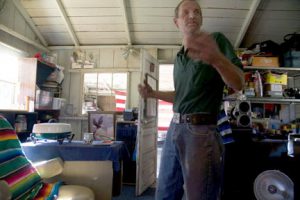Border Communities are Ground Zero for Hunger
Photos and story by David Bacon
New American Media

TIERRA DEL SOL, CA
— The tiny towns in the borderland of East San Diego County —Campo, Boulevard and Tierra del Sol— mark the road north for hundreds of migrants as they cross the border and travel on. Hardly any migrants stay — just those who die in the crossing. Instead, for the people who live here, some with roots going back for generations, these tiny communities are home to growing hunger and poverty.
The border fence is the main feature of the landscape, as it passes through the desert between the U.S. and Mexico, two miles south of Campo. A big Border Patrol station sprawls across several acres just outside this tiny town. Hundreds of people try to walk though the mountains here every month, and many die as they attempt to cross the border. The potters field graveyard in Holtville, a few hours away, is filled with hundreds of graves of those found dead in these hot dry hills.
Up the road from Campo is Boulevard, another tiny town on the border highway. Near it sits “Camp Vigilance,” home to the Minuteman Civil Defense Corps, a rightwing anti-immigrant militia. The camp became notorious after Shawna Forde, recently sent to death row in Arizona for murdering a nine-year-old Mexican girl and her father, stayed there on her way to the shooting.
Until fed-up locals recently stopped it, the Blackwater security company planned to open a clandestine training facility nearby as well. It presumably would have focusing on paramilitary action against the poor farmers and workers making the trek north from Mexico. When company mercenaries were charged with murdering civilians in Baghdad’s Nisour Square, however, the training camp proposal was quickly shelved.
Its little wonder that national media describe this section of the border as immigration ground zero, where border enforcement both by the official authorities, and border violence by right wing militias, is the big story.
But for the people who actually live here, the real story is not having enough to eat. East San Diego County shares with other border communities, from the Rio Grande Valley in Texas to the Imperial Valley just hours east on the highway, the distinction of being the poorest communities in the United States.

Every week, Ken Koppin leaves his shack here on Tierra del Sol Road, where an American flag in the window shades the interior from the sun’s intense heat. He drives up to Highway 94, and there puts out a signboard telling his neighbors that the food pantry will be handing out bags that afternoon.
Around two o’clock a large white truck with murals painted on its sides pulls into the open area beside Koppin’s shack. Willie Mills, an African American driver, pilots it from one border settlement to another, from the suburbs of San Diego itself, through these mountain hamlets, to the border of Imperial County. Koppin says that it was hard at first to find a place for the truck to make its stop in Tierra del Sol, but his landlord finally agreed to let it park here.
Mills and Koppin call for volunteers among the people leaning on their cars or sitting smoking and talking in the shade of a solitary tree. Soon folding tables are set up, and the area’s residents begin parceling out food from bins into bags. Then they all line up, and each person gets whatever the truck is holding that day: oranges, canned milk, potatoes, bread or hot dog buns.
Off to one side sits Jesus Rodriguez. He says he doesn’t know exactly when he was born, but he’s lived his entire life here on the border, over 80 years at least. “My family has always been here,” he says. “We were probably here when this was Mexico.”
This land became part of the U.S. in 1848, after the U.S. army defeated the Mexicans, and General Santana signed the Treaty of Guadalupe Hidalgo giving up what’s now California, Arizona, New Mexico, Texas, and parts of Colorado and Utah. It was only Mexico for 27 years — until Mexican independence in 1821 Spain claimed it as its colony.
But long before the Spanish conquistadores and their friars arrived in the 1700s, native people occupied the land for 10,000 years. The Kumeyaay and Cocopah Indians were its original inhabitants, as late as 1880 Indians resisted outside settlement. Fifteen were massacred that year by ranchers in nearby Jacumba. Today a number of small reservations are scattered through east San Diego County. The Manzanita Band of Diegueno Mission Indians has its tribal office in nearby Boulevard, and sometimes tribe members also get food from the truck.
A Spanish-speaking neighbor has brought Don Jesus, as she calls him in respect for his age, down to the food distribution. “He needs the food, of course,” she says. “But he also needs to get out and see people. He gets depressed living alone by himself, so I make him come. The food feeds his body, and the people here feed his soul.”
Nick, another old man, also comes down to get food, even though he’s also a food producer. He has a small pig farm that actually abuts the border fence itself, down Tierra del Sol Road another three miles. “He’s really too old anymore to slaughter the pigs himself,” Koppin says. “So every now and then I’ll go work with him, and in return I get some of the meat.”
There are no official statistics on hunger specifically in these border communities, but in 2007, 15% of families with children depended on food programs nationally, 20% of Latino and Black families, and a third of families headed by single women. In San Diego County as a whole, over 300,000 people went hungry, and more than twice that didn’t always know where their next meal was coming from. In the current recession, all those numbers are unquestionably higher.
But to Willie Mills, numbers don’t tell the story. “I can see that even though there are fewer people living here than in urban San Diego, they need this food even more,” he explains. “That’s why I drive the truck out here every week. If I didn’t come, I don’t know what would happen to them.” The truck is a project of the San Diego Food Bank and Feeding America, a national food program.
In some ways, the story of the migrants crossing the border and the hungry local residents is much the same. Koppin says, “We see the people coming up the road, or more often, walking cross country from the border. It’s not hard to see how hungry they must be too. We see women walking through, and even children. I hope they find what they’re looking for. It’s very hard to be poor and hungry, whether you live here or you’re just passing through.”


 Arturo Castañares
Arturo Castañares





